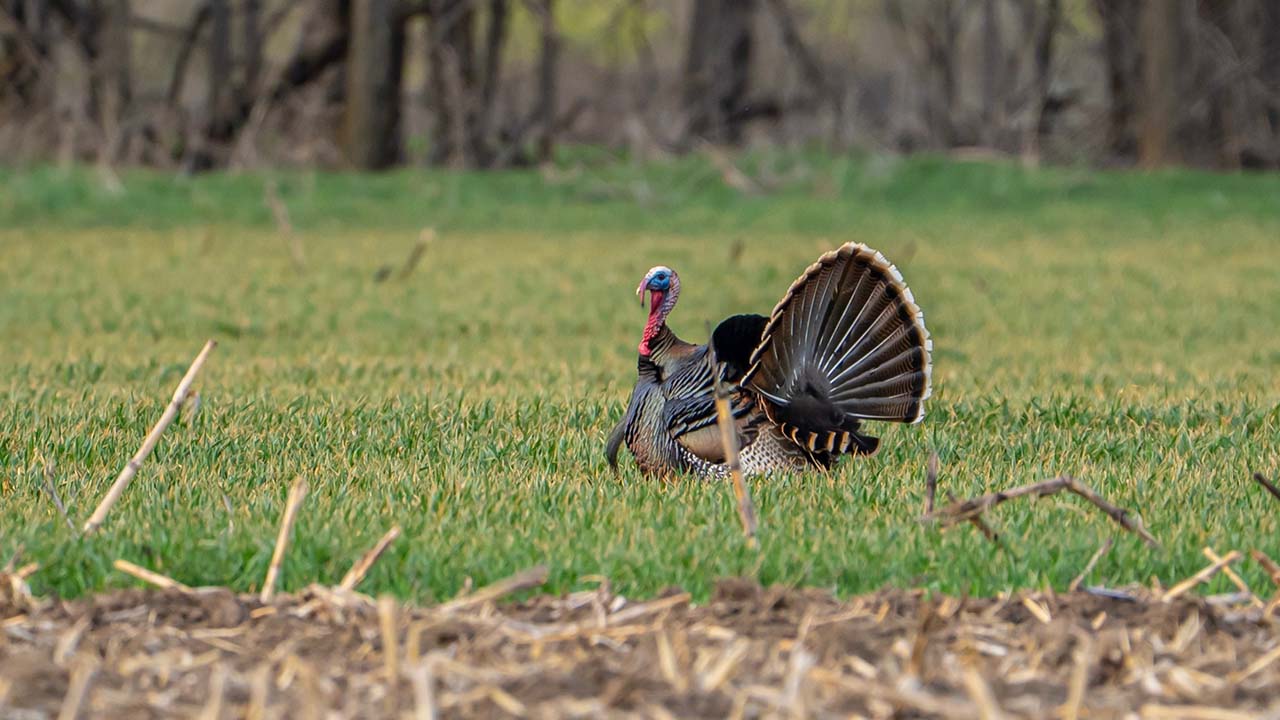- Apr 17, 2025
5 Tips for Turkey Hunting

1. Scout Smart: Know Where the Birds Are
The Importance of Pre-Season Scouting
Scouting is the foundation of a successful turkey hunt. Knowing where turkeys roost, feed, and travel will give you a clear advantage when the season opens. Start scouting weeks before the season begins to track movement patterns and locate prime hunting spots.
Here’s what to look for when scouting turkeys:
- Roosting Areas – Look for trees with large branches where turkeys gather at dusk.
- Strut Zones – Open areas where gobblers display dominance during mating season.
- Feeding Locations – Fields, wooded edges, and plots rich in acorns, insects, and other food sources.
- Travel Corridors – Paths turkeys frequently use between roosting and feeding areas.
Best Moultrie Products for Turkey Scouting


Moultrie’s trail cameras allow hunters to monitor turkey activity without disturbing their habitat. Set up cameras near food sources, roosting areas, and strut zones to gather valuable data before the hunt.
- EDGE 2: Provides real-time scouting with automatic network selection, allowing hunters to track turkeys remotely.
- EDGE 2 PRO – The EDGE 2 PRO captures images and videos faster, uses Live Aim to tweak your camera set-up, and includes GPS so that you never lose track of your camera.
Using the Moultrie App, hunters can access photos and analyze turkey activity to determine when and where to set up on opening day.
2. Master the Art of Calling
Choosing the Right Turkey Calls
Turkey calling is an art, and using the right call at the right time can mean the difference between success and failure. The best turkey hunters use a combination of calls to mimic natural turkey sounds and lure gobblers into range.
Types of turkey calls:
- Box Calls – Easy to use and great for producing loud, realistic yelps and clucks.
- Diaphragm Calls – Hands-free operation, perfect for subtle calling when turkeys are close.
- Slate (Pot) Calls – Create soft purrs, clucks, and yelps, ideal for bringing in wary birds.
When and How to Use Calls Effectively
Morning Calls: Start with soft tree yelps before sunrise to mimic a hen waking up. Increase volume and add excited cutting once the gobblers begin responding.
Midday Calls: Use softer clucks and purrs to keep a gobbler interested.
Evening Calls: Keep it subtle, as turkeys are heading back to the roost.
One common mistake hunters make is calling too much. If a tom is responding but not moving, stay patient and let curiosity draw him in.
3. Concealment is Key
Proper Camouflage & Setup
Turkeys have incredible vision, capable of detecting even the slightest movement. A solid camouflage setup is critical to staying hidden.
- Clothing – Wear full camo, including gloves and a face mask to reduce shine. First Lite has a range of clothing and gear dedicated to turkey hunting, keeping you comfortable and prepared out in the field.
- Patterns – Choose a camo pattern that matches your hunting terrain (wooded, field, or mixed environments).
- Movement – Keep movement to a minimum, especially when a turkey is within range.
Ground Blinds & Strategic Setups
Some hunters prefer ground blinds for added concealment, while others opt for natural cover. Both have advantages:
- Ground Blinds: Best for hunting fields or when introducing a new hunter to turkey hunting.
- Natural Cover: Ideal for staying mobile and adapting quickly to turkey movement.
The key is to set up with the sun behind you and use terrain to break up your outline.
4. Use the Right Turkey Hunting Equipment
Essential Gear for Turkey Hunting
Having the right turkey hunting equipment increases comfort, effectiveness, and success in the field.
- Decoys: A hen decoy can draw in gobblers, while a jake decoy can trigger aggressive responses from dominant toms.
- Comfort & Safety Accessories: Invest in a turkey vest with a built-in seat cushion, knee pads, and mosquito repellent for all-day comfort.
5. Timing & Strategy: The Best Times to Hunt
Understanding Turkey Behavior by Season
Turkeys behave differently throughout the season, so hunters should adjust their tactics accordingly.
- Early Season: Turkeys are still in large winter flocks, requiring softer calling and strategic decoy placement.
- Mid-Season: Gobblers are more aggressive and respond well to loud calling and jake decoys.
- Late Season: Birds are more wary, so low-pressure hunting areas and subtle calling work best.
How to Plan Your Hunt
- Use trail cameras to determine peak turkey activity times and best roosting locations.
- Leverage real-time scouting with the Moultrie App for on-the-go strategy adjustments.
Enjoying the Harvest: Turkey Recipes & Cooking Tips
A successful hunt isn’t just about the harvest—it’s also about enjoying wild game at the table. Check out Moultrie’s wild turkey recipes, such as teriyaki turkey skewers, turkey parmesan sandwiches, and stuffed turkey breast. Using every part of the bird is a great way to honor the hunt and practice ethical hunting traditions.
Turkey hunting requires patience, preparation, and the right equipment. By scouting effectively, mastering calling techniques, concealing yourself properly, using the right gear, and timing your hunt strategically, you can increase your success and enjoy a more rewarding hunting experience.
Turkey Hunting FAQs
Q: When is turkey hunting season in my state?
A: Turkey hunting seasons vary by state and region. Check with your state’s wildlife agency for exact dates and regulations.
Q: How can trail cameras improve my turkey hunting success?
A: Trail cameras help hunters track turkey movement, roosting locations, and feeding patterns, providing real-time scouting data without disturbing the birds.
Q: What are the best turkey hunting accessories?
A: Essential turkey hunting accessories include cellular trail cameras, decoys, and calls to enhance scouting, attract birds, and improve shot opportunities.




